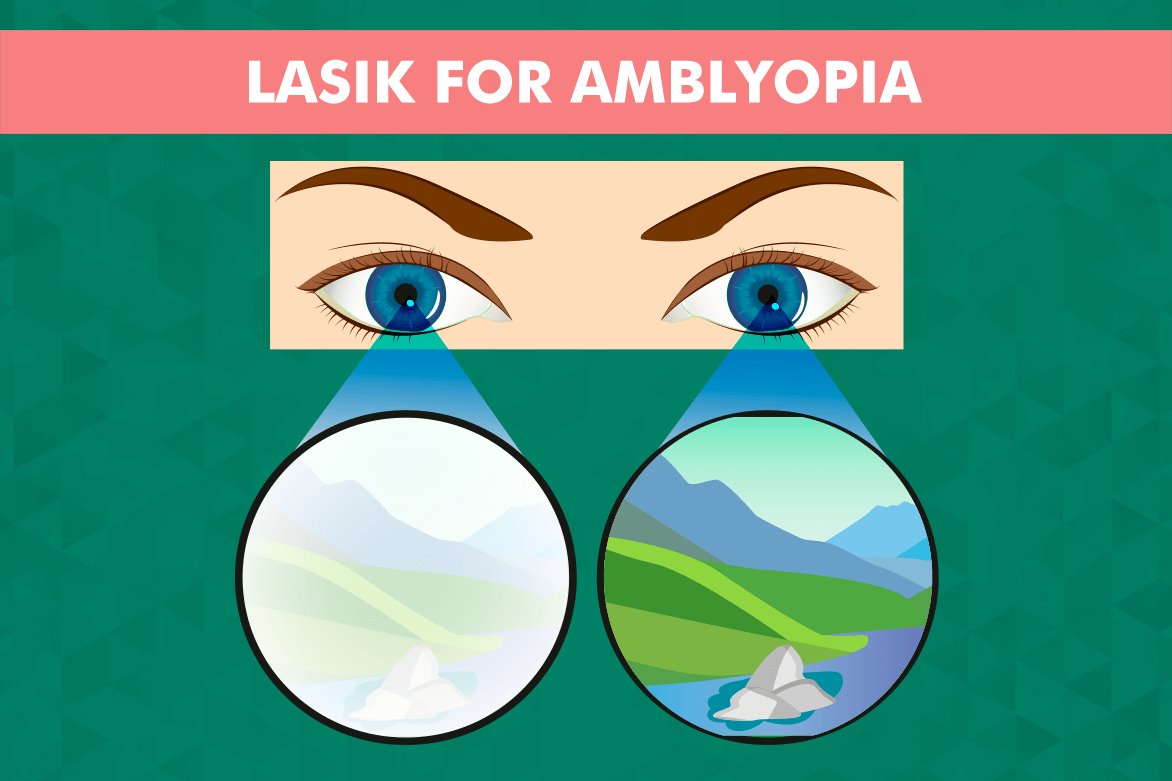
Amblyopia (Lazy Eye) Surgery – Can Lasik Fix Amblyopia?

Amblyopia, commonly known as lazy eye, is a vision disorder that affects the brain’s ability to process visual information correctly. It typically develops during childhood and can result in reduced vision in one eye. While amblyopia is often treatable with non-surgical methods, such as glasses, patches, and vision therapy, some cases may require surgical intervention. One commonly done eye surgery for lazy eye correction is Lasik surgery.
Understanding Amblyopia (Lazy Eye)
Amblyopia is a condition characterized by reduced vision in one eye, despite the absence of any structural abnormalities or eye diseases. The most common cause of amblyopia is a significant difference in refractive error between the two eyes, meaning one eye has a much higher or lower prescription than the other.
Other causes include strabismus (misalignment of the eyes), where one eye turns in or out, and deprivation amblyopia, which occurs when the eye is deprived of clear visual input during critical periods of visual development. Amblyopia can affect various aspects of visual function, such as visual acuity, depth perception, and binocular vision.
Read blog on Vision Correction
What Causes a Lazy Eye?
Amblyopia can be caused by several factors, including:
– Refractive errors: A significant difference in the prescription between the two eyes can lead to amblyopia.
– Strabismus: Misalignment of the eyes can result in amblyopia.
– Deprivation: Conditions that obstruct clear vision in one eye, such as cataracts or droopy eyelids, can cause amblyopia.
It is important to diagnose and have amblyopia surgery early, as the condition is most responsive to treatment during childhood.
What Is Amblyopia Surgery?
Amblyopia eye surgery for lazy eye is a surgical procedure that aims to improve vision in the affected eye. The specific surgical techniques used may vary depending on the underlying cause of amblyopia. In cases where refractive errors are the primary cause, Lasik eye surgery for lazy eye can be considered as a potential treatment option. It involves reshaping the cornea using a laser to correct refractive errors, such as nearsightedness, farsightedness, and astigmatism.
When Is Surgery an Option for Amblyopia?
Amblyopia Surgery is typically considered as an option for amblyopia when non-surgical treatments, such as glasses and vision therapy, have been unsuccessful. It is important to consult with an ophthalmologist or a pediatric ophthalmologist to determine the most appropriate treatment approach for each individual case of amblyopia. The decision to undergo eye surgery for lazy eye should be based on a thorough evaluation of the potential benefits and risks, as well as the individual’s specific needs and circumstances.
Traditional Treatments for Amblyopia
Before considering Amblyopia surgery, traditional treatments for amblyopia are usually explored. These treatments may include:
– Glasses or contact lenses to correct refractive errors and improve visual acuity in the affected eye.
– Patching therapy, where the stronger eye is covered with a patch to encourage the weaker eye to develop better visual acuity.
– Vision therapy exercises to improve eye coordination, focusing abilities, and visual processing skills.
These non-surgical treatments are often effective in improving vision and reducing the impact of amblyopia.
Lasik Surgery for Amblyopia
Lasik surgery has gained popularity as a potential surgical option for amblyopia. The procedure involves creating a thin flap on the cornea, which is then lifted to allow the laser to reshape the underlying tissue. By correcting refractive errors, Lasik surgery aims to improve visual acuity in the affected eye and potentially enhance binocular vision.
However, it is important to note that Lasik surgery as amblyopia surgery is still considered an experimental treatment and may not be suitable for all individuals with the condition.
Considerations Before Opting for Lasik Surgery
Before considering Lasik as amblyopia surgery, there are several important factors to consider:
– Age: Though Lasik surgery is typically not recommended for children under the age of 18, as their eyes are still developing, but in cases of lazy eye, the doctor may need to operate it at a younger age.
– Stability of refractive errors: The refractive errors should be stable for at least a year before considering Lasik surgery.
– Overall eye health: The health of the eye, including the cornea, should be assessed to determine the suitability for surgery.
It is crucial to consult with an experienced ophthalmologist who can evaluate these factors and provide personalized recommendations.
Benefits and Risks of Lasik for Amblyopia
While Lasik surgery may offer potential benefits for amblyopia, it is essential to understand the associated risks:
– Undercorrection or overcorrection of refractive errors is possible, which can lead to suboptimal visual outcomes.
– Dry eye syndrome may occur as a side effect of amblyopia surgery.
– Flap-related complications, such as infection or dislocation, can occur.
– The long-term effects of Lasik surgery on visual function and stability of amblyopia are still being studied.
It is crucial to discuss these risks and benefits with the ophthalmologist and make an informed decision based on individual circumstances.
Alternative Eye Surgery for Lazy Eye
In addition to Lasik surgery, there are other surgical options of amblyopia surgery, like:
– Strabismus surgery: If misalignment of the eyes (strabismus) is the primary cause, then amblyopia surgery may be recommended to correct the alignment .
– Cataract surgery: In cases where cataracts contribute to amblyopia, removing the cataract through surgery may improve visual acuity.
These alternative surgeries should be considered based on the underlying cause of amblyopia and the recommendations of the ophthalmologist.
FAQs
What is amblyopia, and how does it affect vision?
Amblyopia is commonly known as “lazy eye” and refers to reduced vision in one or both eyes due to abnormal visual development during childhood.
How common is amblyopia, and at what age does it typically occur?
Amblyopia affects about 2-3% of the population. It typically occurs before the age of 7, but it can also develop during infancy or early childhood.
What are the main causes of amblyopia?
Main causes include strabismus (misaligned eyes), significant differences in refractive errors between the eyes (anisometropia), or deprivation of clear vision in one eye due to factors like cataracts or ptosis.
What are the symptoms of amblyopia, and how is it diagnosed?
Symptoms include poor depth perception, squinting, or tilting the head. Diagnosis involves comprehensive eye exams, including visual acuity tests and evaluations for eye misalignment.
What are the treatment options for amblyopia?
Treatment options include corrective lenses, eye patches, vision therapy, or a combination of these methods to strengthen the weaker eye and encourage visual development. Another option is Amblyopia surgery.
Read blog on 20-20 Vision
How does amblyopia surgery work, and when is it recommended?
Amblyopia surgery involves procedures to correct eye misalignment (strabismus surgery) or remove obstructions like cataracts. It’s recommended when other treatments haven’t been successful.
What are the risks and complications associated with amblyopia surgery?
Risks and complications of surgery may include infection, bleeding, or overcorrection/undercorrection of eye alignment, leading to potential visual disturbances.
What is the success rate of amblyopia surgery?
Success rates of amblyopia surgery vary depending on factors like the severity and the chosen surgical approach. Generally, success rates range from 60% to 90%, with some cases requiring additional interventions.
